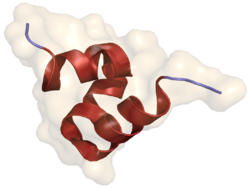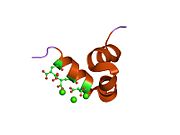- Osteocalcin
-
Osteocalcin, also known as bone gamma-carboxyglutamic acid-containing protein (BGLAP), is a noncollagenous protein found in bone and dentin. In humans, the osteocalcin is encoded by the BGLAP gene.[1][2]
Contents
Function
Osteocalcin is secreted solely by osteoblasts and thought to play a role in the body's metabolic regulation and is pro-osteoblastic, or bone-building, by nature.[3] It is also implicated in bone mineralization and calcium ion homeostasis. Osteocalcin acts as a hormone in the body, causing beta cells in the pancreas to release more insulin, and at the same time directing fat cells to release the hormone adiponectin, which increases sensitivity to insulin.[3]
Current data suggests a possible role of osteocalcin in male fertility.[4] Research from Columbia University Medical Center proposes that osteocalcin may enhance the synthesis of testosterone, which is a hormone believed to regulate aspects of male fertility.[5] Although these studies were originally performed by one laboratory (Dr. Gerard Karsenty), at least two other groups have independently confirmed the role of osteocalcin in insulin secretion. [6] [7]
Use as a biochemical marker for bone formation
As osteocalcin is produced by osteoblasts, it is often used as a marker for the bone formation process. It has been observed that higher serum-osteocalcin levels are relatively well correlated with increases in bone mineral density (BMD) during treatment with anabolic bone formation drugs for osteoporosis, such as Forteo. In many studies, osteocalcin is used as a preliminary biomarker on the effectiveness of a given drug on bone formation.
References
- ^ Puchacz E, Lian JB, Stein GS, Wozney J, Huebner K, Croce C (May 1989). "Chromosomal localization of the human osteocalcin gene". Endocrinology 124 (5): 2648–50. doi:10.1210/endo-124-5-2648. PMID 2785029.
- ^ Cancela L, Hsieh CL, Francke U, Price PA (September 1990). "Molecular structure, chromosome assignment, and promoter organization of the human matrix Gla protein gene". J. Biol. Chem. 265 (25): 15040–8. PMID 2394711.
- ^ a b Lee NK, Sowa H, Hinoi E, Ferron M, Ahn JD, Confavreux C, Dacquin R, Mee PJ, McKee MD, Jung DY, Zhang Z, Kim JK, Mauvais-Jarvis F, Ducy P, Karsenty G (August 2007). "Endocrine regulation of energy metabolism by the skeleton". Cell 130 (3): 456–69. doi:10.1016/j.cell.2007.05.047. PMC 2013746. PMID 17693256. http://www.pubmedcentral.nih.gov/articlerender.fcgi?tool=pmcentrez&artid=2013746.
- ^ Franck Oury, Grzegorz Sumara, Olga Sumara, Mathieu Ferron, Haixin Chang, Charles E. Smith, Louis Hermo, Susan Suarez, Bryan L. Roth, Patricia Ducy et al. Endocrine Regulation of Male Fertility by the Skeleton. Cell, 17 February 2011 DOI: 10.1016/j.cell.2011.02.004
- ^ http://en.wikipedia.org/wiki/Testosterone
- ^ Pi M, Wu Y, Quarles DL (July 2011). "GPRC6A mediates responses to osteocalcin in beta-cells in vitro and pancreas in vivo". JBMR 26 (7): 1680–1683. doi:10.1002/jbmr.390. PMID 21425331.
- ^ Fulzele K, Riddle RC, DiGirolamo DJ, Cao X, Wan C, Chen D, Faugere MC, Aja S, Hussain MA, Brüning JC, Clemens TL (July 2010). "Insulin receptor signaling in osteoblasts regulates postnatal bone acquisition and body composition". Cell 142 (2): 309–19. doi:10.1016/j.cell.2010.06.002. PMC 2925155. PMID 20655471. http://www.pubmedcentral.nih.gov/articlerender.fcgi?tool=pmcentrez&artid=2925155.
Further reading
- Kamdem LK, Hamilton L, Cheng C, et al. (2008). "Genetic predictors of glucocorticoid-induced hypertension in children with acute lymphoblastic leukemia.". Pharmacogenet. Genomics 18 (6): 507–14. doi:10.1097/FPC.0b013e3282fc5801. PMID 18496130.
- Lin GT, Tseng HF, Chang CK, et al. (2008). "SNP combinations in chromosome-wide genes are associated with bone mineral density in Taiwanese women.". Chin J Physiol 51 (1): 32–41. PMID 18551993.
- Lumachi F, Camozzi V, Tombolan V, Luisetto G (2009). "Bone mineral density, osteocalcin, and bone-specific alkaline phosphatase in patients with insulin-dependent diabetes mellitus.". Ann. N. Y. Acad. Sci. 1173 Suppl 1: E64-7. doi:10.1111/j.1749-6632.2009.04955.x. PMID 19751417.
- Kanazawa I, Yamaguchi T, Yamamoto M, et al. (2009). "Serum osteocalcin/bone-specific alkaline phosphatase ratio is a predictor for the presence of vertebral fractures in men with type 2 diabetes.". Calcif. Tissue Int. 85 (3): 228–34. doi:10.1007/s00223-009-9272-4. PMID 19641839.
- Makita N, Suzuki M, Asami S, et al. (2008). "Two of four alternatively spliced isoforms of RUNX2 control osteocalcin gene expression in human osteoblast cells.". Gene 413 (1-2): 8–17. doi:10.1016/j.gene.2007.12.025. PMID 18321663.
- Desbois C, Karsenty G (1995). "Osteocalcin cluster: implications for functional studies.". J. Cell. Biochem. 57 (3): 379–83. doi:10.1002/jcb.240570302. PMID 7768973.
- Salem AM, Zohny SF, Abd El-Wahab MM, Hamdy R (2007). "Predictive value of osteocalcin and beta-CrossLaps in metastatic breast cancer.". Clin. Biochem. 40 (16-17): 1201–8. doi:10.1016/j.clinbiochem.2007.07.006. PMID 17889845.
- Im JA, Yu BP, Jeon JY, Kim SH (2008). "Relationship between osteocalcin and glucose metabolism in postmenopausal women.". Clin. Chim. Acta 396 (1-2): 66–9. doi:10.1016/j.cca.2008.07.001. PMID 18657532.
- Ba Y, Huang H, Yang Y, et al. (2009). "The association between osteocalcin gene polymorphism and dental fluorosis among children exposed to fluoride in People's Republic of China.". Ecotoxicol. Environ. Saf. 72 (8): 2158–61. doi:10.1016/j.ecoenv.2009.08.014. PMID 19767102.
- Hwang YC, Jeong IK, Ahn KJ, Chung HY (2009). "The uncarboxylated form of osteocalcin is associated with improved glucose tolerance and enhanced beta-cell function in middle-aged male subjects.". Diabetes Metab. Res. Rev. 25 (8): 768–72. doi:10.1002/dmrr.1045. PMID 19877133.
- Yerges LM, Klei L, Cauley JA, et al. (2009). "High-density association study of 383 candidate genes for volumetric BMD at the femoral neck and lumbar spine among older men.". J. Bone Miner. Res. 24 (12): 2039–49. doi:10.1359/jbmr.090524. PMC 2791518. PMID 19453261. http://www.pubmedcentral.nih.gov/articlerender.fcgi?tool=pmcentrez&artid=2791518.
- Yu S, Jiang Y, Galson DL, et al. (2008). "General transcription factor IIA-gamma increases osteoblast-specific osteocalcin gene expression via activating transcription factor 4 and runt-related transcription factor 2.". J. Biol. Chem. 283 (9): 5542–53. doi:10.1074/jbc.M705653200. PMID 18171674.
- Kayed H, Bekasi S, Keleg S, et al. (2007). "BGLAP is expressed in pancreatic cancer cells and increases their growth and invasion.". Mol. Cancer 6: 83. doi:10.1186/1476-4598-6-83. PMID 18163903.
- French D, Hamilton LH, Mattano LA, et al. (2008). "A PAI-1 (SERPINE1) polymorphism predicts osteonecrosis in children with acute lymphoblastic leukemia: a report from the Children's Oncology Group.". Blood 111 (9): 4496–9. doi:10.1182/blood-2007-11-123885. PMID 18285546.
- Pittas AG, Harris SS, Eliades M, et al. (2009). "Association between serum osteocalcin and markers of metabolic phenotype.". J. Clin. Endocrinol. Metab. 94 (3): 827–32. doi:10.1210/jc.2008-1422. PMID 19088165.
- Kindblom JM, Ohlsson C, Ljunggren O, et al. (2009). "Plasma osteocalcin is inversely related to fat mass and plasma glucose in elderly Swedish men.". J. Bone Miner. Res. 24 (5): 785–91. doi:10.1359/jbmr.081234. PMID 19063687.
- Wahlgren CM, Zheng W, Shaalan W, et al. (2009). "Human carotid plaque calcification and vulnerability. Relationship between degree of plaque calcification, fibrous cap inflammatory gene expression and symptomatology.". Cerebrovasc. Dis. 27 (2): 193–200. doi:10.1159/000189204. PMID 19136823.
- Lumachi F, Ermani M, Camozzi V, et al. (2009). "Changes of bone formation markers osteocalcin and bone-specific alkaline phosphatase in postmenopausal women with osteoporosis.". Ann. N. Y. Acad. Sci. 1173 Suppl 1: E60-3. doi:10.1111/j.1749-6632.2009.04953.x. PMID 19751416.
- Born AK, Rottmar M, Lischer S, et al. (2009). "Correlating cell architecture with osteogenesis: first steps towards live single cell monitoring.". Eur Cell Mater 18: 49–60, 61–2; discussion 60. PMID 19856264.
- Fujisawa R (2002). "[Recent advances in research on bone matrix proteins]". Nippon Rinsho 60 Suppl 3: 72–8. PMID 11979972.
External links
PDB gallery Cell signaling: calcium signaling / calcium metabolism Cell membrane Ion pumpsAdhesion moleculesOtherIntracellular signaling
& calc. regulationSecond messengersChelators and calcium sensorsCalbindin · S100 · pervalbumin · Calretinin · Calsequestrin · Sarcalumenin · Phospholamban · SynaptotagminsCytoskeleton remodeling proteinsOtherCalcium-binding
protein domainsExtracellular ligands Calcium-binding proteins Vitamin D-dependent calcium-binding protein/Calbindin - Calexcitin - Calsequestrin - Osteocalcin - Osteonectin - S-100 - SynaptotagminEndocrine system: hormones (Peptide hormones · Steroid hormones) Endocrine
glandsTestis: testosterone · AMH · inhibin
Ovary: estradiol · progesterone · activin and inhibin · relaxin (pregnancy)
Placenta: hCG · HPL · estrogen · progesteroneIslet-Acinar
AxisNon-end.
glandsThymus: Thymosin (Thymosin α1, Thymosin beta) · Thymopoietin · Thymulin
Digestive system: Stomach: gastrin · ghrelin · Duodenum: CCK · GIP · secretin · motilin · VIP · Ileum: enteroglucagon · peptide YY · Liver/other: Insulin-like growth factor (IGF-1, IGF-2)
Adipose tissue: leptin · adiponectin · resistin
Skeleton: Osteocalcin
Kidney: JGA (renin) · peritubular cells (EPO) · calcitriol · prostaglandin
Heart: Natriuretic peptide (ANP, BNP)Categories:- Human proteins
- Peptide hormones
- Hormones of bone
Wikimedia Foundation. 2010.



